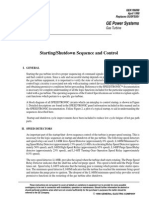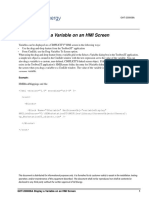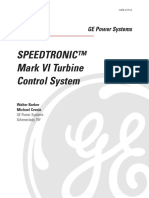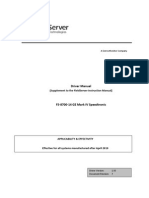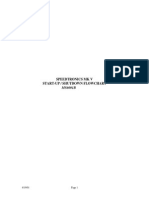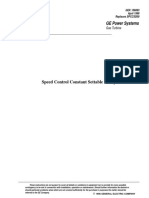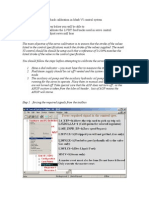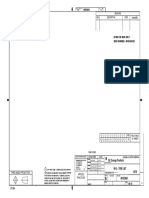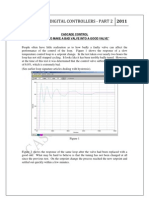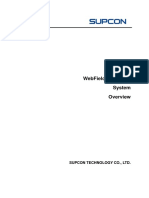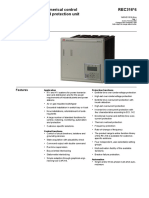Mark VI
Mark VI
Uploaded by
Ahmed EldosokyCopyright:
Available Formats
Mark VI
Mark VI
Uploaded by
Ahmed EldosokyOriginal Title
Copyright
Available Formats
Share this document
Did you find this document useful?
Is this content inappropriate?
Copyright:
Available Formats
Mark VI
Mark VI
Uploaded by
Ahmed EldosokyCopyright:
Available Formats
GEI-100472
g
GE Industrial Systems
SPEEDTRONICTM Mark VI TMR
New Unit, Heavy Duty Gas Turbine Control
These instructions do not purport to cover all details or variations in equipment, nor to
provide every possible contingency to be met during installation, operation, and maintenance.
If further information is desired or if particular problems arise that are not covered
sufficiently for the purchaser’s purpose, the matter should be referred to GE Industrial
Systems.
This document contains proprietary information of General Electric Company, USA, and is
furnished to its customer solely to assist that customer in the installation, testing, operation,
and/or maintenance of the equipment described. This document shall not be reproduced in
whole or in part, nor shall its contents be disclosed to any third party without the written
approval of GE Industrial Systems.
Section Page
Introduction ............................................................................................................2
Redundancy ............................................................................................................3
I/O Interface............................................................................................................3
Built-in Diagnostics ................................................................................................5
System Overview ....................................................................................................5
Control Functions....................................................................................................7
Sequencing .............................................................................................................9
Protection ...............................................................................................................9
Operator Screens...................................................................................................12
Typical Turbine Instrumentation............................................................................15
Packaging .............................................................................................................17
Power Requirements .............................................................................................18
Acronyms and Abbreviations ................................................................................18
CIMPLICITY is a registered trademark of GE Fanuc Automation North America, Inc.
Ethernet is a trademark of the Xerox Corporation.
SPEEDTRONIC is a trademark of General Electric Company, USA.
Windows NT is a registered trademark of Microsoft Corporation.
Introduction
The high reliability achieved The SPEEDTRONIC Mark VI gas turbine control is a Triple Modular Redundant
by the TMR control system is (TMR), microprocessor-based control with a heritage of over 30 years of successful
due to the integration of the turbine automation. The basis of this system is the three redundant control modules
triple redundant electronics <R>, <S>, and <T>. Each controller contains its own power supply, processor,
and sensors into a robust, communications, and I/O for all of the critical control, protection and monitoring of
fault tolerant control system. the gas turbine. Some critical functions, such as emergency overspeed protection and
the phase-slip windows for backup synch check protection, are monitored by a
separate triple redundant backup protection module <P>. Most of the critical sensors
for control loops and trip protection are triple redundant. Other sensors are dual or
single element devices.
Backup Protection Module
3 Independent Sections
3 Control Modules
Mark VI Electronics
2 • SPEEDTRONIC, Mark VI TMR GEI-100472
Redundancy
An important part of the fault tolerant control architecture is the method of reliably
voting the inputs and outputs. Each control module reads its inputs and exchanges
the data with the other two control modules every time the application software is
executed at 40 ms.
In addition, a 1ms time stamp The voted value of each contact input and the median value of each analog input is
is assigned to each contact calculated within each control module, and then used as the control parameter for the
input to provide a built-in application software. Diagnostic algorithms monitor these inputs and initiate an
sequence of events (SOE) alarm if any discrepancies are found between the three sets of inputs.
monitor.
Redundant contact inputs for trip functions are connected to three separate
termination points and then individually voted. This enables the control system to
survive multiple failures of contact or analog inputs without causing an erroneous
trip command as long as the failures are not from the same circuit, such as lube oil
pressure.
An equally important part of the fault tolerance is the hardware voting of analog and
contact outputs. Three coil servos on the valve actuators are separately driven from
each control module, and the position feedback is provided with redundant linear
variable differential transformers (LVDTs). Contact outputs to the hydraulic trip
solenoids are voted with three magnetic relays on each side of the floating 125 V dc
feeder to the solenoids.
I/O Interface
The I/O is designed for direct interface to turbine and generator devices, such as
vibration sensors, flame sensors, LVDTs, magnetic speed pickups, thermocouples,
and Resistance Temperature Devices (RTDs). Direct monitoring of these sensors
eliminates the need for interposing instrumentation with its associated single point
failures, reduces long-term maintenance, and enables the Mark VI diagnostics to
directly monitor the health of the sensors on the machinery. This data is then
available to both local operator/maintenance stations and to the plant Distributed
Control System via communication links.
Contact Inputs are powered from the 125 V dc battery bus through the Mark VI
termination boards. Each contact input is optically isolated and has a 1 ms time
stamp for SOE monitoring. Contacts are open-to-alarm and open-to-trip. An
inversion mask is applied to each contact input to normalize the data values and
simplify understanding of the software. For example, 63QT is a low lube oil pressure
trip switch that will open-to-trip. The inversion mask is applied such that whenever
logic L63QT = 1 it means that there is low lube oil pressure. Conversely, if the field
contact was closed-to-trip, the inversion mask would be 0 and L63QT = 1 would still
mean that there is low lube oil pressure.
Contact Outputs are from plug-in, magnetic relays with dry, form C contact
outputs. The control provides a floating 125 V dc source and suppression for each
solenoid with a 3.2 A slow-blow fuse on each side of the 125 V dc feeder.
GEI-100472 SPEEDTRONIC, Mark VI TMR • 3
Analog inputs can monitor 4-20 mA (250 ohms), which can be configured for self-
powered, differential inputs, or as sensors that use a +24 V dc supply from the
turbine control. Selected inputs can be configured for 0-1mA inputs (5,000 ohms), or
±5, 10 V dc inputs. Analog outputs can be configured for 4-20 mA output (500
ohms max) or 0-200 mA output (50 ohms max).
Gas turbine temperatures are monitored by type K thermocouples. Critical
temperatures, such as exhaust temperature have multiple thermocouples that are
divided between the three control modules for redundancy. Non-critical
thermocouples, such as wheelspace and bearing temperatures, are connected to one
thermocouple card in one control module, but the data is transmitted to all three main
processors for monitoring and alarming. The control can interface with grounded or
ungrounded thermocouples, and software linearization is provided for types E, J, K,
or T.
Generator temperatures are normally monitored with grounded 100 ohm platinum
RTDs. The control can interface with grounded or ungrounded RTDs. Software
linearization is provided for 10 ohm copper, 100/200 ohm platinum, or 120 ohm
nickel RTDs.
Speed Inputs include three passive, magnetic, speed sensor inputs. The median
value is used for speed control and primary overspeed protection in the control
modules. Three additional speed sensors are provided for emergency overspeed
protection. These sensors are monitored by the three sections of the backup
protection module and diagnostics are transmitted between the backup protection
module and the control modules for cross-tripping and alarm management.
The control monitors redundant Reuter Stokes type UV flame scanners and initiates
an alarm if the light intensity diminishes below an acceptable level due to carbon
buildup or other contaminants on the scanner windows.
Servo valve interface is described in the section, Control Functions.
Seismic (velocity) Vibration Transducers are monitored directly by the Mark VI
for trip protection of the turbine and generator. These devices generate a small output
current by passing a magnet through a fixed coil, thereby eliminating the need for
excitation current. All vibration sensors are continuously monitored for faults, alarm
levels, and trip levels. Protection features include:
Standard vibration protection • A start check permissive is inhibited if three or more turbine sensors or two or
in Mark VI card rack. more generator sensors are disabled or faulty.
• An automatic shutdown sequence is initiated if all turbine or all generator
sensors are disabled or faulty.
• A trip is initiated if one turbine vibration sensor indicates a trip level and any
other turbine sensor indicates an alarm level.
• A trip is initiated if one turbine vibration sensor indicates a trip level and any
adjacent pair of turbine sensors are disabled or indicates an alarm level.
• A trip is initiated if one turbine vibration sensor indicates a trip level and two or
more sensor inputs are disabled.
4 • SPEEDTRONIC, Mark VI TMR GEI-100472
An option is available for Bently Nevada Proximitors for monitoring only. The
Proximitors can be supplied as either an interface to a Bently Nevada 3300 or 3500
monitor with an additional option for a Data Manager 2000 or as a direct interface to
the turbine control. A Mark VI option is available for buffered outputs to BNC
connectors to facilitate plug-in analysis instrumentation and direct plug connection
from the Mark VI termination boards to 3500 monitors.
Note The mission of the turbine control is to provide alarm and trip protection,
whereas the mission of the Bently Nevada is to facilitate vibration analysis.
Complete synchronizing The Synchronizing Interface uses a pair of single-phase potential transformers
system: auto, manual, and (PT), which are monitored by the control modules. It matches the turbine speed to
backup synch check the line frequency and match the generator and line voltages via the Unit Data
protection.. Highway (UDH) to the generator excitation system. A command is issued to close
the breaker based on a calculated breaker closure time. Diagnostics monitor the
actual breaker closure time and self-correct each time the breaker closes. The single
phase PTs are paralleled to the triple redundant backup protection module for the
backup synch check protection. The synch check protection is used to backup the
automatic synchronizing and the manual synchronizing which is implemented from a
synchroscope screen on a Human-Machine Interface (HMI) server. Three-phase PT
inputs from the generator and line, and single-phase current transformer (CT) inputs
are normally monitored by the generator protection and the EX2000.
Built-in Diagnostics
The Mark VI control system has extensive built-in diagnostics and includes
powerup, background, and manually initiated diagnostic routines. These diagnostics
are capable of identifying both control panel, sensor, and output device faults. These
faults are identified down to the board level for the panel, and to the circuit level for
the sensors and actuators.
System Overview
The control system consists of several networks. IONET is the Ethernet-based
network for communication between the three control modules, the three sections of
the protection module, and any expansion modules. IONET uses asynchronous
drives language (ADL) to poll the modules for data instead of using the typical
collision detection techniques used in Ethernet local area networks (LAN).
Ethernet networks with peer- The UDH is an Ethernet-based network that provides peer-to-peer communications
to-peer communication between the turbine control, the generator excitation control, and the static starter.
between turbine and The network uses Ethernet Global Data (EGD), which is a message-based protocol
generator controls. with support for sharing information with multiple nodes based on the UDP/IP
standard. Data can be transmitted unicast or broadcast to peer control systems on the
network. Data (4K) can be shared between up to 10 nodes at 25 Hz.
The Mark VI is used to control megawatt output, and the EX2000 is used to control
megavar output. The generator protection panel (GPP) is used to provide primary
protection for the generator. Additional protection features are located in the
EX2000. Although the UDH is capable of communicating control data, control loops
are closed internal to the turbine or generator control.
GEI-100472 SPEEDTRONIC, Mark VI TMR • 5
In the case of var/power factor control for the generator or tie-line, the turbine
control performs the regulation of the setpoint and transmits the command to adjust
the generator field on the UDH to the excitation control. All trip commands are hard-
wired between control units, including any trip commands coming from remote
control systems such as a Distributed Control System (DCS).
An optional OSI PI- based Dual servers (CIMPLICITY/Windows NT) are available to isolate the UDH
Historian is available for from the Plant Data Highway (PDH). These servers can be used as local or remote
long term data archiving and operator and/or maintenance stations and configured in a variety of arrangements.
retrieval. Typically, one server is located in each Packaged Electrical and Electronic Control
Compartment (PEECC) that contains a turbine control, a generator protection panel,
a motor control center, and the 125 V dc batteries. The primary server can be
provided with a time synchronization interface to a Global Time Source (GTS),
which is normally implemented with IRIG-B. A backup time master can be provided
in a backup server. Network Time Protocol (NTP) is used for internal time
synchronization with ±1 ms time coherence.
Plant DCS Network
Ethernet TCP-IP GSM
Ethernet TCP-IP Modbus
RS232/485 Modbus
IRIG-B
Time Synch
Local Local
Engineer's
Operator Operator
Station
Station Station
Gas Turbine #1 Gas Turbine #2 Steam Turbine
Unit Data Highway - Ethernet Network Time Protocol NTP
Gas Turbine Generator Gas Turbine Generator Static Starter Steam Turbine Generator
Control Excitation Control Excitation Control Excitation
Mark VI EX2000 Mark VI EX2000 Mark VI EX2000
Typical 207FA Control Network
The Plant Data Highway is used to communicate data to the plant distributed control
system or other third party platforms. A variety of protocols are supported for
communication with a plant DCS including RS-232C and RS-485 Modbus remote
terminal unit (RTU) master/slave, Ethernet TCP-IP Modbus slave, and Ethernet
TCP-IP with GEDS Standard Messages (GSM). The GSM protocol provides the
following messages:
• Administration
• Spontaneous Event Driven (with local time tags)
• Periodic Group Data (at rates to 1 second)
• Common Request
6 • SPEEDTRONIC, Mark VI TMR GEI-100472
Control Functions
Startup Control is an open loop system that increases the fuel stroke reference
(FSR) as the turbine startup sequence progresses to preassigned plateaus.
Acceleration Control adjusts the FSR according to the rate of change of the turbine
speed to reduce the thermal shock to the hot gas path parts of the turbine.
Speed Control uses the median speed from three speed sensors for droop and
isochronous speed control with an automatic transfer to isochronous upon loss of the
tie-line breaker.
The FSR is determined by the Load Control compares the load setpoint with the MW feedback from a single-
control parameter calling for phase transducer and adjusts the speed setpoint to regulate the load. Selection of fast
the least fuel. load start or pre-selected load will raise the setpoint to the pre-selected load limit.
Selection of base or peak will raise the setpoint to the maximum limit.
Exhaust Temperature Control thermocouples are divided between the three
control modules for redundancy. All of the temperature data is transmitted to all of
the control modules that sort the data from the highest to the lowest temperature,
automatically reject bad thermocouple data, average the remaining data values, and
then execute the control algorithm. Three redundant transducers are supplied for
monitoring the compressor discharge pressure and biasing the temperature control to
correct for ambient temperature and the corresponding variations in mass flow.
Inlet Guide Vane Control modulates the position of the compressor stator vanes to
provide optimum compressor and unit operation. During startup, the guide vanes
open as the turbine speed increases. When the unit is online, the guide vanes
modulate to control turbine airflow temperature to optimize combustion system and
combine cycle performance.
Fuel Control consists of a reference from the governor and feedback of the fuel
control valves. The FSR is determined by the turbine parameter (speed, temperature,
and so on.) calling for the least fuel. Calculation of the FSR is performed in the main
processor and transmitted to the servo valve cards on the backplane of the control
modules. High speed regulation of the servo loop with LVDT position feedback is
performed on each servo card to obtain the maximum performance.
In liquid fuel control systems, FSR establishes the called for stroke of the bypass
valve. Fuel flow is proportional to the speed (fuel flow = speed X FSR). In gas fuel
systems with only a gas control valve, the fuel flow is a function of pressure (fuel
flow = pressure X FSR); therefore, a stop/speed ratio valve is added, which is
programmed by speed. Pressure is now a function of speed and the liquid fuel control
system and the gas fuel control system have the same characteristic (refer to the
following diagram).
GEI-100472 SPEEDTRONIC, Mark VI TMR • 7
Control Module Gas Fuel
Termination Stop/Speed
Main Processor VCMI VSVO Card
Board Ratio Valve
Card
Constants
FPRG
Software Servo
Logic D/A
Regulator 90SR
TSVO
TNH (Speed) +
A/D LVDT
-
96SR
Gas Fuel
Pressure
VAIC Card TBAI
D/A 96FG
Gas Control
VSVO Card
Valve
Logic
FSROUT
Software Servo
D/A
Regulator 65GC
TSVO
A/D LVDT
96GC
FSR2
Combustion
Logic Chamber
Fuel
FSR Splitter
Stop/Speed
Ratio Valve
FSR1 Pulse Flow
A/D
77FD Divider
VSVO Card TSVO
FSROUT
TNH (Speed)
Logic Software Servo
D/A
Regulator 65FP
Liquid Fuel
Duel Fuel Control System
Generator Excitation Setpoints for volts (voltage matching during
synchronization) and var/power factor control for the generator and tie-line are in the
turbine control. References come from operator commands, and feedback comes
from a single-phase var transducer. Power factor is calculated from watts and vars.
Setpoints are transmitted from the turbine control to the generator excitation control
on the UDH.
Synchronizing is described in the section, I/O Interface.
Emissions Control is available with diluent (water or steam) injection through a
multi-nozzle quiet combustor to quench flame temperature and reduce thermal NOX
formation. Lean-burning, pre-mixed flame combustors are available for lower NOX
levels without the need for water or steam injection (dry low nox).
8 • SPEEDTRONIC, Mark VI TMR GEI-100472
Sequencing
This automation enables The turbine control includes a completely automated startup and shutdown sequence,
operation of the gas turbine including interface to all of the auxiliary systems in the motor control center and
from a remote (off-site) generator protection system. Operators can choose to have the turbine automatically
location with the assurance sequence to intermediate hold points by selecting Crank or Fire without enabling
that the turbine is fully automatic synchronization. All ramp rates and hold times are pre-programmed for
protected and diagnostics will optimum performance, and counters record the number of starts, shutdowns, trips
capture and record any and running time under various conditions in non-volatile memory. Counters and
abnormal conditions that may timers for a 7FA, gas fuel, and dry low Nox (DLN) turbine are as follows:
occur.
Timers Counters
Total Fired Time Manually Initiated Starts
DLN Primary Mode Total Starts
DLN Lean-lean Mode Fast Load Starts
DLN Premix Mode Fired Starts
DLN Extended Lean-Lean Mode Emergency Trips
Protection
The turbine control system monitors all control and protection parameters and
initiates an alarm if an abnormal condition is detected. If the condition exceeds a
predefined trip level, the turbine control will drive the gas/liquid control valves to a
zero flow position and de-energize the hydraulic trip solenoids. Since this action is
vital to protecting the turbine, the electronics are triple redundant.
All of the control, protection, and monitoring algorithms are contained in the control
modules for efficiency in sharing the common data used in these calculations.
Backup protection for emergency overspeed and synch check protection is
performed in the protection module.
GEI-100472 SPEEDTRONIC, Mark VI TMR • 9
Primary
Overspeed
Combustion
Monitor
<R> Fuel To
Loss Of Flame
Module Turbine
<S> Fuel Control Fuel
Rotor Vibration Control
Module System Valve
Fuel
Compressor <T> Hydraulic Trip Stop
Ratio
Surge Module System Valve
TMR Applications
Fire Protection
System
<P> Protection Module
High Lube Oil <X> Steam Turbine
Header Temp. Section Stop Valves
For Single Shaft STAG
Generator <Y>
Synchronization Section
Steam Cycle
Trip System
Emergency <Z>
Overspeed Section
For Turbines With No
Exhaust Mech. Overspeed Bolt
Overtemperature
Generator Synch
Check Protection
Manual Low Hydraulic
Customer Protect. Low Lube Oil Manual
Emergency Supply / Trip
Shutdown Pressure Hydraulic Trip
Trip Pressure
Typical Protection System
Each trip solenoid is powered from the 125 V dc floating battery bus with contacts
from the control module in series with the negative side of the bus and contacts from
the backup protection module in series with the positive side of the bus. Since there
are three control modules and three sections of the backup protection module, each
trip solenoid has three relays from the control module voting on one side and three
relays from the backup protection module voting on the other side.
10 • SPEEDTRONIC, Mark VI TMR GEI-100472
Diagnostics monitor a contact from each relay and also monitor the voltage directly
across the trip solenoid. For added insurance, diagnostic and trip data are
communicated between the control modules and the backup protection modules on
the triple redundant IONets for cross-tripping.
Overspeed protection consists of a primary overspeed monitoring system in the three
control modules and an emergency overspeed monitoring system in the backup
protection module, which replaces the mechanical overspeed bolt used on older
turbines. Each control module and each section of the backup protection module
monitors a separate passive magnetic speed sensor (6 total) from 2 rpm on a 60 tooth
wheel. Diagnostics monitor the speed and acceleration and exchange the data
between the control modules and the backup protection module on startup to verify
that all sensors are active.
The following is a list of typical trips supplied on a 7FA, gas fuel, DLN turbine.
Pre-ignition Trips Post-ignition Trips General Trips
Auxiliary Check (Servos) Loss of Flame Starting Device Trouble
Seal Oil DC Motor Undervoltage High Exhaust Temperature Inlet Guide Vane Trouble
DC Lube Oil Pump Exhaust Thermocouples Open Manual Trip
Undervoltage
Failure to Ignite on Gas Fuel Compressor Bleed Valve Position Control Speed Signal Lost - HP
Trouble
Load Tunnel Temperature High Protective Speed Signal Trouble
Red. Sensor Gas Fuel Hydraulic Control Speed Signal Trouble
Pressure Low
Turbine Lube Oil Header Gas CV Not Following Reference
Temperature
Turbine Electronic Overspeed Secondary CV Not Following Ref.
Dry Low Nox System Trip PM3 CV Not Following Reference
Compressor Operating Limit Error Quaternary CV Not Following Ref.
Control System Fault
Low Lube Oil Pressure
Fire Indication
Generator Differential Trip
Lockout
Transf. Differential Trip Lockout
Exhaust Pressure High
Breaker Failure Trip Lockout
Vibration Trip
Startup Fuel Flow Excessive
Loss of Protection HP Speed
Inputs
Customer Trip
GEI-100472 SPEEDTRONIC, Mark VI TMR • 11
Operator Screens
The operator/maintenance interface is commonly referred to as the Human Machine
Interface (HMI). It is a PC with a GE CIMPLICITY graphics screen system, a
Microsoft Windows NT operating system, a Control System Toolbox with editors for
the application software and unit specific screens. This interface can be applied as:
• primary operator interface for one or multiple units
• backup operator interface to the plant DCS operator interface
• gateway for communication links to other control systems
• permanent or temporary maintenance station
• engineer’s workstation
All control and protection is resident in the turbine control, which allows the HMI to
be a non-essential component of the control system. It can be reinitialized or
replaced with the turbine running with no impact on the control system. The HMI
communicates with the processor card in the turbine control via the Ethernet-based
UDH.
Operator Interface Graphics
12 • SPEEDTRONIC, Mark VI TMR GEI-100472
Gas turbine control screens show a diagram of the turbine with the primary control
parameters. The diagram is repeated on most of the screens to enable operators to
maintain a visual picture of the turbine’s performance while changing screens. Some
screens such as the exhaust temperature monitor and the static starter screen have
unique graphics. All screens have a menu on the right-hand side of the display,
which has a hierarchy of an Overview screen (for a multiple unit site), Unit selection
(such as GT1 or GT2), Control/Monitor/Auxiliaries/Tests screen category selection,
and a sub-menu of specific screens for each category.
Typical Gas Turbine Screens
Control Screens Monitor Screens Auxiliaries Tests
Startup Bearing Temperature Flame Overspeed Tests
Dry Low Nox Exhaust Temperature Generator Capability
FSR Control Generator RTDs Start Check
Generator/Exciter Hydrogen Static Starter
IGV Control Seismic Vibration Timers
Motors Wheelspace Temperature Trip Diagram
Synchronizing Water Wash
The primary screen in the system is the Startup screen. Since the gas turbine control
provides fully automatic startup including all interface to auxiliary systems, an
operator can initiate all of the basic commands and observe all of the primary control
parameters and status conditions from this single screen.
All operator commands can be given through momentary pushbutton commands on
the screen. The command is sent to the Mark VI control where the application
software initiates the requested action assuming that the appropriate permissives are
satisfied. A response to the command can be observed within one second, if it does
not involve subsequent system time delays like purging.
As an example, if Ready to Start is displayed in the Startup Status field, a Start
command can be given. A small pop-up window displays above the Start button for
the operator to verify the start of the turbine. Upon verification, the application
software checks the startup permissives and initiates a startup sequence, which
displays Starting and Sequence in Progress messages on the left side of the screen.
The purpose of the alarm If the unit was not ready to start, then the message Not Ready to Start displays and
queue is to identify any an alarm message displays in the bottom left-hand corner of the screen identifying
abnormal condition including the reason. In addition, there is a Start Check screen (under Auxiliaries), which
any reason to inhibit a start provides a graphical representation and status of the Start Check / Ready to Start
sequence. permissives. This graphic also relates to the functional organization of the
application software for the Start Check/Ready to Start Permissives. Similarly, all
trips displayed in the alarm field and in the Trip Diagram under Auxiliaries. If a
latched trip is the reason for not being ready to start, then the operator must select
the Master Reset button on the Startup screen. This references another screen to
remind the operator to investigate the latched trip prior to issuing a Master Reset.
GEI-100472 SPEEDTRONIC, Mark VI TMR • 13
In some cases, it is more convenient for the operator to change a setpoint, such as
MW, by typing in a numerical value for the setpoint rather than issuing raise/lower
commands. This capability is provided, and the application software in the Mark VI
automatically compares the requested setpoint with acceptable limits and determines
a suitable rate to ramp the setpoint to the new target.
A Startup Trend can be selected with pre-assigned parameters for the mean exhaust
temperature, speed, maximum vibration, compressor discharge pressure, inlet guide
vane position, and the fuel stroke reference. More detailed information and trending
are provided on supporting screens, and customized trends can be created too.
14 • SPEEDTRONIC, Mark VI TMR GEI-100472
Typical Turbine Instrumentation
Redundant and Multiple Sensors
Device Parameter Function Device Type Quantity Redundant
26QA/T Lube oil temp high A/P Temp switch 3 S
28FD Flame detector A/P UV scanner 4/8 S
33FL Liquid fuel stop valve M Limit switch 2 S
39VX Vibration sensor A/P Velocity pu 2 S
45FX Fire detector A/P Temp switch 2* S
63HG Gas fuel trip oil pressure A/P Press switch 3 D
63HL Liquid fuel trip oil pressure A/P Press switch 3 D
63QA/T Lube oil hydraulic pressure A/P Press switch 3 S
63TF Inlet filter pressure C/P Press switch 3 D
65FP Liquid fuel pump servo C 3 coil servo 1 D
65GC Gas control valve servo C 3 coil servo 1 D
77FD Liquid fuel flow C/P Magnetic pu 3 D
77NH Speed magnetic pickup C Magnetic pu 3 D
77NT Speed magnetic pickup A/P Magnetic pu 3 D
77WN Water flow magnetic pu C Magnetic pu 4 S
90SR Gas ratio valve servo C 3 coil servo 1 D
90TV Inlet guide vane servo C 3 coil servo 1 D
96FG-2 Gas fuel control pressure C Transducer 3 D
96GC Gas control valve C LVDT 2 S
96SR Gas ratio valve C LVDT 2 S
96TV Inlet guide vane C LVDT 2 S
CTDA Compressor discharge M TC 2 S
temperature
CTIF Compressor inlet temperature M TC 2 S
FTGI-x Fuel gas supply temperature C TC 3 D
ST-SJ-x Steam supply pressure C TC 3 D
TTWS-x GT wheelspace temperature A/P TC 2/w S
TTXD-x GT exhaust temperature C/P TC 18* D/S
* All channels/locations except one are redundant by means of two sensors per location. The non-redundant
location has one sensor.
The number of exhaust thermocouples (TCs) varies with the gas turbine (GT) model from 13 to 27. TCs are
divided between the control modules for redundancy.
Legend: S = Shared D = Dedicated A = Alarm M = Monitor P = Protection C = Control
GEI-100472 SPEEDTRONIC, Mark VI TMR • 15
Non-Redundant Sensors (Partial Listing)
Device Parameter Function Device Type Quantity
12HA Mechanical overspeed bolt sensor A/P Limit switch 1
20FG Gas fuel trip oil C Solenoid valve 1
20FL Liquid fuel trip oil C Solenoid valve 1
26FD Liquid fuel temperature C Temp switch 1
26QL/M Lube oil temperature low / moderate C Temp switch 1 each
26QN Lube oil temperature normal P Temp switch 1
33CS Starting clutch M Limit switch 1
33HR Ratchet position C/A Limit switch 1
39FC Cooler fan vibration A Vibration switch 1/fan
63AD Atomizing air differential pressure A Pressure switch 1
63FD Liquid fuel pressure A* Pressure switch 1
63FG Gas fuel pressure A* Pressure switch 1
63LF1 Liquid fuel filter pressure A Pressure switch 1
63LF2 Liquid fuel forwarding filter pressure A Pressure switch 1
63QA Lube oil pressure P Pressure switch 1
63QL Lube oil pressure P Pressure switch 1
63TK Exhaust frame cooling pressure A/P Pressure switch 1/fan
63WC Cooling water pressure low A Pressure switch 1
71QH Lube tank high level A Level switch 1
71QL Lube tank low level A Level switch 1
71WL Water tank low level A Level switch 1
96FF-1 Gas fuel flow pressure C Transducer 1
96FG1 Gas fuel supply pressure C Transducer 1
*Can be used to initiate a transfer from primary to backup fuel.
Legend: S = Shared D = Dedicated A = Alarm M = Monitor P = Protection C = Control
16 • SPEEDTRONIC, Mark VI TMR GEI-100472
Packaging
Cabinet access: Front door access only
Card Backplane: VME type (VERSA Module Eurocard)
Cabinet: NEMA 1 convection cooled, similar to IP-20
Cable Entrance: Top and/or bottom
Finish: E-coat primed, pebble gray – RAL 7032 Door, rear wall, roof: powder
painted
Locks: Lockable door
Material: Sheet steel
Terminal Blocks: (24) point, barrier type terminal blocks that can be unplugged for
maintenance. Each screw can terminate (2) #12 AWG (3.0mm2), 300 V insulated
wires.
Weight: 3,500 lbs. (1,587 kg.)
Type Width Depth Height
3 cabinet lineup with 1 Control Cabinet & 2 Termination Cabinets 4,200 mm 602mm 2,324mm
(Typical for 7FA) 165.4 inches 23.7 inches 91.5 inches
2 cabinet lineup with 1 Control Cabinet & 1 Termination Cabinet 2,600 mm 602mm 2,324mm
(Typical for 7EA) 102.4 inches 23.7 inches 91.5 inches
GEI-100472 SPEEDTRONIC, Mark VI TMR • 17
Power Requirements
The control cabinet is powered from the 125 V dc battery bus and short circuit
protected in the motor control center. Both sides of the floating 125 V dc bus are
continuously monitored with respect to ground. The 125 V dc is fuse isolated in the
Mark VI power distribution module and fed to the internal power supplies for the
control modules, the termination boards for the field contact inputs, and to the
termination boards for the turbine solenoids. Additional 3.2 A fuse protection is
provided on the termination board for each solenoid. Separate 120 V ac feeds are
provided from the motor control center for the ignition transformers. Auxiliary
120/240 V ac sources can be provided for cabinet power if required. A separate UPS
is required for power to the HMI and network equipment.
Control Cabinet Power
Steady-State Voltage Frequency Load Comments
125 V dc (100 to 145Vdc) 10 A dc Ripple <= 5% Add 0.5 A dc continuous for each dc
solenoid
120 V ac (105 to 132 V ac) 47 - 63Hz 15 A rms Harmonic distortion < 7% Add 6.0 A rms for a continuously
powered ignition transformer
240 V ac (210 to 264 V ac) 47 - 63 Hz 7.5 A rms Harmonic distortion < 7 % Add 3.5 A rms for a continuously
powered ignition transformer
Acronyms and Abbreviations
TMR Triple Modular Redundant PDH Plant Data Highway
SOE Sequence of Events PEECC Packaged Electrical and Electronic Control Compartment
LVDT Linear Variable Differential GTS Global Time Source
Transformers
RTD Resistance Temperature Device IRIG-B Inter-Range Instrumentation Group
UDH Unit Data Highway NTP Network Time Protocol
HMI Human-Machine Interface RTU Remote Terminal Unit
CT Current Transformer GSM GEDS Standard Messages
ADL Asynchronous Drives Language FSR Fuel Stroke Reference
EGD Ethernet Global Data DLN Dry Low Nox
GPP Generator Protection Panel GT Gas Turbine
TC Thermocouple PT Potential Transformer
DCS Distribution Control System
g
GE Industrial Systems
Issue date: 2000-07-05 General Electric Company
2000 by General Electric Company, USA.
All rights reserved. 1501 Roanoke Blvd.
Salem, VA 24153-6492 USA
You might also like
- Edt Testkompress by Kiran K S: Embedded Deterministic TestDocument51 pagesEdt Testkompress by Kiran K S: Embedded Deterministic Testsenthilkumar90% (10)
- B-64513EN - 01 Fanuc PMC ProgrammingDocument1,366 pagesB-64513EN - 01 Fanuc PMC ProgrammingDmitry75% (8)
- Ge Mark V Mark Vi Mark Vie Gas Turbine ControlswwwcaledonianturbineservicescompdfcaledoniangepdfDocument8 pagesGe Mark V Mark Vi Mark Vie Gas Turbine ControlswwwcaledonianturbineservicescompdfcaledoniangepdfAsish Thampi100% (2)
- Mark VI Manual Vol 1Document164 pagesMark VI Manual Vol 1Mitrofan Mihai100% (3)
- GT Trip ProtectionsDocument2 pagesGT Trip Protectionsakeel_haq100% (10)
- Troubleshooting Failure To Reach I/O Status A7: GE Power Systems Training and DevelopmentDocument15 pagesTroubleshooting Failure To Reach I/O Status A7: GE Power Systems Training and DevelopmentIsmail Djeghoubbi100% (3)
- Motor Protection ManualDocument20 pagesMotor Protection ManualNirmal mehtaNo ratings yet
- SRS TemplateDocument25 pagesSRS TemplateRomeoNo ratings yet
- ELT1130 Anatomy of A Robot NotesDocument15 pagesELT1130 Anatomy of A Robot NotesEd PawliwNo ratings yet
- I007 - ET - April-2009 Megger MagazineDocument8 pagesI007 - ET - April-2009 Megger MagazineMiguel AngelNo ratings yet
- Mark VI For Gas Turbine Control Retrofits Application OverviewDocument22 pagesMark VI For Gas Turbine Control Retrofits Application Overviewcrsswa100% (4)
- GE Industrial SystemsDocument20 pagesGE Industrial Systemsfishzee100% (2)
- Speedtronic™ Mark Vi TMR: GE Industrial SystemsDocument19 pagesSpeedtronic™ Mark Vi TMR: GE Industrial Systemsnboulegroune100% (3)
- Servo Valve Null Bias CurrentDocument41 pagesServo Valve Null Bias CurrentRam Meena100% (1)
- GCV - SRV Overhauling and Calibration - Automation & Control Engineering ForumDocument1 pageGCV - SRV Overhauling and Calibration - Automation & Control Engineering Forumعبدالسلام المبروك ابوزناد100% (1)
- Presentation Slides - Mark VIEDocument33 pagesPresentation Slides - Mark VIEolegprikhodko2809100% (2)
- Tab 05 GEK 106899 Startup and Shutdown ControlDocument10 pagesTab 05 GEK 106899 Startup and Shutdown Controlherysyam100% (3)
- GT ControlDocument81 pagesGT ControlYazid Rasid100% (6)
- MARK V Diagnostic AlarmsDocument32 pagesMARK V Diagnostic AlarmsChidiebere Samuel Okogwu67% (3)
- Basics in Intrumentation in Mark-VDocument11 pagesBasics in Intrumentation in Mark-VGnanaseharan Arunachalam100% (1)
- GE - Mark V Turbine ControlDocument1 pageGE - Mark V Turbine ControlAdil Butt0% (1)
- MOU - Mark VI - ADVANCEDDocument110 pagesMOU - Mark VI - ADVANCEDمحمد أبو لؤي100% (4)
- Gas Turbine ControlDocument8 pagesGas Turbine ControlDAHRAOUI Mohamed Riad100% (2)
- GHT-200008 How To Display A Variable On An HMI ScreenDocument6 pagesGHT-200008 How To Display A Variable On An HMI ScreenjosseNo ratings yet
- Speed RPM To % Convertion: - CommentDocument2 pagesSpeed RPM To % Convertion: - CommentLusi ArsenalNo ratings yet
- Speedtronic Mark Vie Training Course Section 8Document31 pagesSpeedtronic Mark Vie Training Course Section 8cucumelero barrios100% (3)
- 125 V DC Fault AlarmDocument7 pages125 V DC Fault AlarmThetTinAung100% (1)
- IGV, Servos and LVDT - Automation & Control Engineering ForumDocument1 pageIGV, Servos and LVDT - Automation & Control Engineering ForumHBNBIL100% (2)
- Ger 4193a Speedtronic Mark VI Turbine Control System PDFDocument18 pagesGer 4193a Speedtronic Mark VI Turbine Control System PDFzizu123450% (2)
- Geh 6759 PDFDocument172 pagesGeh 6759 PDFHung NgoNo ratings yet
- GHT-200003 How To Download A Mark VIe Controller and IP AddressDocument8 pagesGHT-200003 How To Download A Mark VIe Controller and IP Addressjosse100% (1)
- Testing Spark Plugs of Mark-V Control SystemDocument21 pagesTesting Spark Plugs of Mark-V Control SystemMuhammad Usman100% (1)
- Calibration ProcedureDocument2 pagesCalibration ProcedureChidiebere Samuel Okogwu100% (2)
- 5 - LOGIC BANHA G1 p741 PDFDocument1,622 pages5 - LOGIC BANHA G1 p741 PDFsmart_eng2009100% (3)
- Main Valve Adjustment Procedure of Mark VIDocument19 pagesMain Valve Adjustment Procedure of Mark VImohamed abouraya100% (1)
- GT LogicsDocument1,232 pagesGT Logicssrinivas100% (5)
- On Mark Vi ControlDocument27 pagesOn Mark Vi Controlatreya_baruaa94% (34)
- Fundamentals of Speedtronic CopieDocument21 pagesFundamentals of Speedtronic CopieHassanSaidi100% (1)
- GEH-6721Q Vol IDocument148 pagesGEH-6721Q Vol IJorge Contreras100% (1)
- Isochronous and DroopDocument15 pagesIsochronous and DroopNadeem Khan100% (2)
- I Am Wondering If There Is Any Value To Adding Cdms To My GT With Dln. Does Anyone Have These Systems? and If So Which Ones Would You RecommendDocument11 pagesI Am Wondering If There Is Any Value To Adding Cdms To My GT With Dln. Does Anyone Have These Systems? and If So Which Ones Would You RecommendSahariar Bin Shafique100% (1)
- 000start CDDocument1,170 pages000start CDEd Conrreales Arriojas100% (6)
- FS-8700-14 GE Mark IV SpeedtronicDocument13 pagesFS-8700-14 GE Mark IV SpeedtronicEric DunnNo ratings yet
- Gas Turbine ControlDocument9 pagesGas Turbine ControlHBNBIL100% (2)
- Woodward MicroNet™ Plus - Product SpecificationDocument4 pagesWoodward MicroNet™ Plus - Product SpecificationMagoroku D. YudhoNo ratings yet
- GTDocument122 pagesGTAnand Patel100% (1)
- Tab 07 Startup and Shutdown Flow ChartDocument12 pagesTab 07 Startup and Shutdown Flow Chartherysyam100% (1)
- Detail Writeup of MarkvieDocument128 pagesDetail Writeup of Markvieramkrishna100% (1)
- TAB01 MKVIE Hadware OverviewDocument48 pagesTAB01 MKVIE Hadware OverviewAmirouche Benlakehal100% (1)
- Ex2100e GE PDFDocument118 pagesEx2100e GE PDFFerio Arsyad100% (1)
- Gek 106893 Speed Cotnrol Constant Settable DroopDocument9 pagesGek 106893 Speed Cotnrol Constant Settable DroopZaki noui100% (1)
- 5 Trenders - 5Document41 pages5 Trenders - 5smart_eng2009100% (2)
- Sevo CalibrationDocument6 pagesSevo Calibrationlagoskaduna100% (2)
- Mark Vies Safety Controller: Block LibraryDocument92 pagesMark Vies Safety Controller: Block Libraryazizi re100% (1)
- Learn Gas Turbine by SimulationDocument41 pagesLearn Gas Turbine by SimulationAnonymous 8RRc42G100% (2)
- GT Trips List Generic PDFDocument13 pagesGT Trips List Generic PDFHassanSaidi100% (1)
- GT 9E StartupDocument41 pagesGT 9E StartupNaveed Irshad100% (1)
- GEH-6422 Turbine Historian System Guide PDFDocument292 pagesGEH-6422 Turbine Historian System Guide PDFmeirangong100% (1)
- GEH-6421 - Vol - I Mark VIDocument238 pagesGEH-6421 - Vol - I Mark VICharles Wilson100% (1)
- Mark6 To OvationDocument8 pagesMark6 To Ovationtriplbingazi100% (2)
- Application Mark VI ViewDocument21 pagesApplication Mark VI ViewSana Mansour AlghiryaniNo ratings yet
- GE Speedtronic Mark VDocument14 pagesGE Speedtronic Mark VRyan Anthony Umali50% (4)
- GSM Based Distribution Transformer Monitoring and Controlling System Ijariie1748Document3 pagesGSM Based Distribution Transformer Monitoring and Controlling System Ijariie1748Velu SamyNo ratings yet
- Ge Mark ViDocument22 pagesGe Mark Vichudyace100% (4)
- Speedtronic Mark VI Control Configuration and Operation Part 1 - Power Industry NewsDocument7 pagesSpeedtronic Mark VI Control Configuration and Operation Part 1 - Power Industry NewsShumraiz M100% (1)
- Auma ManualDocument17 pagesAuma ManualAhmed EldosokyNo ratings yet
- Sl. No. Activity Observation SignatureDocument2 pagesSl. No. Activity Observation SignatureAhmed EldosokyNo ratings yet
- GT SystemsDocument54 pagesGT SystemsAhmed Eldosoky100% (2)
- The Instrument CalibrationDocument2 pagesThe Instrument CalibrationAhmed EldosokyNo ratings yet
- Catalytic CombustionlDocument2 pagesCatalytic CombustionlAhmed EldosokyNo ratings yet
- International System'S Units: Jebel Ali Power PlantDocument14 pagesInternational System'S Units: Jebel Ali Power PlantAhmed EldosokyNo ratings yet
- Cascade LoopDocument6 pagesCascade LoopAhmed EldosokyNo ratings yet
- Fire & Gas Detection Philosophy Part 1 - Fire Detection - Instrumentation and Process ControlDocument6 pagesFire & Gas Detection Philosophy Part 1 - Fire Detection - Instrumentation and Process ControlAhmed EldosokyNo ratings yet
- BurnerDocument33 pagesBurnertoficNo ratings yet
- A Seminar On Virtual Keyboard: Shikha Gaur EC (A) Roll No - 50 Graphic Era UniversityDocument16 pagesA Seminar On Virtual Keyboard: Shikha Gaur EC (A) Roll No - 50 Graphic Era UniversityShruti ChaudharyNo ratings yet
- SET-103. RFID Based Security Access Control SystemDocument3 pagesSET-103. RFID Based Security Access Control SystemShweta dilip Jagtap.No ratings yet
- CX Programer-Help-OMRON FB Library Reference Ver.090612: CPU Position ControllerDocument31 pagesCX Programer-Help-OMRON FB Library Reference Ver.090612: CPU Position ControllerbobNo ratings yet
- Amoozesh Mabani PLCDocument79 pagesAmoozesh Mabani PLCحمیدرضا حاجی علیانیNo ratings yet
- JX-300XP System OverviewDocument37 pagesJX-300XP System Overviewsugeng wahyudiNo ratings yet
- Rec 316 4Document38 pagesRec 316 4sereneNo ratings yet
- Embedded SystemDocument42 pagesEmbedded SystemAssini HussainNo ratings yet
- Bachelor of Computer Applications Syllabus For 2018 & 2019 BatchDocument9 pagesBachelor of Computer Applications Syllabus For 2018 & 2019 BatchRaza KhanNo ratings yet
- DOCA0123EN-04 - SmartlinkDocument192 pagesDOCA0123EN-04 - SmartlinkСергей ГригоровичNo ratings yet
- Man 979 06102011manualDocument210 pagesMan 979 06102011manualWhite MirageNo ratings yet
- Student Report Card Management Using C++: February 2021Document6 pagesStudent Report Card Management Using C++: February 2021Sarthak LonkarNo ratings yet
- Modern Application DevelopmentDocument6 pagesModern Application DevelopmentDrishya ShrivastavaNo ratings yet
- IBM Knowledge Center - SWIFT Message Block StructureDocument5 pagesIBM Knowledge Center - SWIFT Message Block StructureaNo ratings yet
- Hmi DVP PDFDocument160 pagesHmi DVP PDFAdayroi AtuNo ratings yet
- 1.02 The Main Components of Computer SystemsDocument9 pages1.02 The Main Components of Computer SystemsRachita Shah[Parel]No ratings yet
- Marketing Sample - Click Start 3Document33 pagesMarketing Sample - Click Start 3Samer dawanNo ratings yet
- PTQ Pdpmv1 App Ref GuideDocument242 pagesPTQ Pdpmv1 App Ref GuideJosé Marino Parra TorizNo ratings yet
- C - in One Day - The Ultimate Be - W.B EanDocument130 pagesC - in One Day - The Ultimate Be - W.B EanCarlos Mayorga100% (1)
- Contest1 TasksDocument8 pagesContest1 Tasksada2000No ratings yet
- Disk Operating System (DOS) : Reference NotesDocument11 pagesDisk Operating System (DOS) : Reference NotesMohammad AsimNo ratings yet
- uPI Confidential: High Efficiency PMIC With Dynamic Voltage ManagementDocument42 pagesuPI Confidential: High Efficiency PMIC With Dynamic Voltage ManagementEvgeniy MiroshnichenkoNo ratings yet
- Appendix A. Virtual-Key Codes: Symbolic Constant Name Value (Hexadecimal) MeaningDocument11 pagesAppendix A. Virtual-Key Codes: Symbolic Constant Name Value (Hexadecimal) MeaningGuilhermeMirandaNo ratings yet
- Computer 6 Week 3 and 4 Computer LanguagesDocument3 pagesComputer 6 Week 3 and 4 Computer LanguagesTitser ArMack Adrocat MendozaNo ratings yet
- CM 300Document47 pagesCM 300alvhann_1No ratings yet
- DHI-DSS4004: General Surveillance Management CenterDocument3 pagesDHI-DSS4004: General Surveillance Management CenterAndresNo ratings yet
















